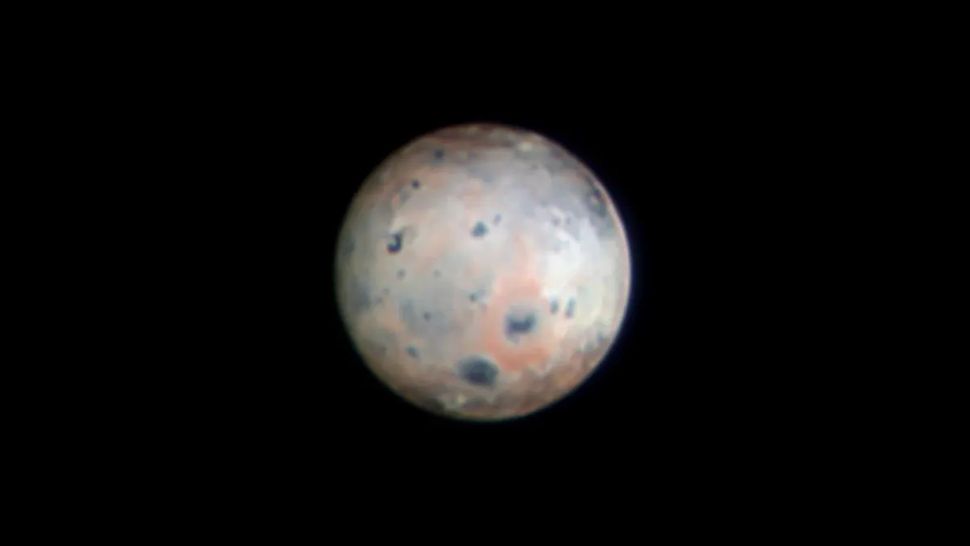Science
Related: About this forumA telescope on Earth just took an unbelievable image of Jupiter's moon
By Sharmila Kuthunur
published June 6, 2024
Astronomers using the Large Binocular Telescope in Arizona have taken a close-up picture of Jupiter's volcanic moon Io that rivals similar photos taken from space.

Jupiter's moon Io
The image combines three spectral bands — infrared, red and yellow — to highlight the reddish ring around the volcano Pele (below and to the right of the moon's center) and the white ring around Pillan Patera, to the right of Pele. (Image credit: INAF/Large Binocular Telescope Observatory/Georgia State University; IRV-band observations by SHARK-VIS/F. Pedichini; processing by D. Hope, S. Jefferies, G. Li Causi)
Using a telescope perched on a mountain in Arizona, scientists have managed to take snapshots of Jupiter's active moon Io — and these images are so detailed they even rival pictures of the world taken from space.
To capture these views, the team used a camera, dubbed SHARK-VIS, that was recently installed on the Large Binocular Telescope (LBT) located on Arizona's Mt. Graham; the new images outline features on Io's surface as small as 50 miles (80 kilometers) wide — a resolution that was, until now, possible only with spacecraft studying Jupiter. "This is equivalent to taking a picture of a dime-sized object from 100 miles (161 kilometers) away," according to a statement by the University of Arizona, which manages the telescope.
The new pictures of Io are, in fact, so intricate that scientists could discern overlapping deposits of lava spewed by two active volcanoes just south of the moon's equator. An LBT image of Io taken in early January shows a dark red ring of sulfur around Pele, which is a prominent volcano routinely spewing Alaska-size plumes up to 186 miles (300 kilometers) above Io's surface. That ring appears partly obscured by white debris (representing frozen sulfur dioxide) from a neighboring volcano named Pillan Patera, which is known to erupt less frequently. By April, Pele's red ring is once again seen nearly complete in images taken by NASA's spacecraft Juno during its closest flyby past the moon in two decades, revealing a fresh dump of erupted material by the active volcano.
"It's kind of a competition between the Pillan eruption and the Pele eruption, how much and how fast each deposits," study co-author Imke de Pater of the University of California, Berkeley, said in another statement. "As soon as Pillan completely stops, then it will be covered up again by Pele's red deposits."
More:
https://www.livescience.com/space/jupiter/a-telescope-on-earth-just-took-an-unbelievable-photo-of-jupiters-moon
KS Toronado
(19,565 posts)Hermit-The-Prog
(36,587 posts)KS Toronado
(19,565 posts)
smb
(3,585 posts)
Judi Lynn
(162,374 posts)Judi Lynn
(162,374 posts)duckworth969
(966 posts)Yikes!
fargone
(218 posts)Hermit-The-Prog
(36,587 posts)NJCher
(37,866 posts)One of these in the compost bin today.
calimary
(84,310 posts)It does kinda look like that. Just fascinating to see what else is circling our sun - and in this case, what else is circling the planets circling our sun. Absolutely remarkable!
PoindexterOglethorpe
(26,727 posts)stupid political connections.
This is serious stuff, and has NOTHING to do with politics.
My Son The Astronomer does exo-planet research. Astronomy is important, and worth paying attention to.